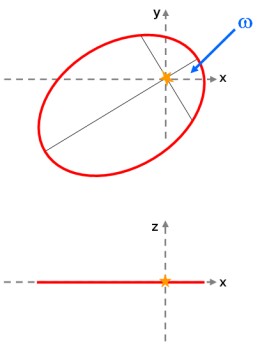MargaritaMc wrote:Is it possible for you to give an example drawn from, say Mars? Something whose orbit I am familiar with? Or Pluto, if it's better to have an example of an orbit that is eccentric and oblique (is that the right term for the slant of Pluto's orbital plane?)
The above image shows the six conventional (Keplerian) orbital elements. The three that are easy to understand are the inclination, which is the angle the orbit is tipped out of a reference plane. When we're talking about Solar System bodies that orbit the Sun, that reference plane is almost always the ecliptic. Also easy to understand is the eccentricity, which describes just how close or far from circular the elliptical orbit is. And the last simple one is the semi-major axis, which describes the size of the ellipse (equivalent to radius for a circle). Also pretty easy to understand is the longitude of the ascending node, which is an angle from a reference direction (the northbound equinox) that describes where the body in an inclined orbit passes upwards across the ecliptic.
The two less obvious elements are the argument of perihelion (or periapsis), which describes how the elliptical orbit is rotated with respect to the ecliptic- specifically, the angle of the perihelion point with respect to the ascending node. Imagine an elliptical plate that you've tossed onto the table, and it does a sort of rotating dance before settling down. At any point in that dance, its argument of perihelion is changing. And finally, the mean anomaly is what tells you where in the orbit you actually find the body. That is, all five of the first terms just describe the shape of the orbital path. The mean anomaly is the only one that is a function of time- where on the path the body is at that time.
I don't know how an example with a planet would be more helpful. Most planets have such low inclinations and nearly circular orbits that it actually obscures the meaning of some orbital elements. Pluto is pretty different, so we can look at that. Maybe it will help. Here are its orbital elements:
Code: Select all
Semimajor axis (AU) 39.48168677
Orbital eccentricity 0.24880766
Orbital inclination (deg) 17.14175
Longitude of ascending node (deg) 110.30347
Longitude of perihelion (deg) 224.06676
Mean longitude (deg) 238.92881
It's an elliptical orbit, with a maximum distance from the ellipse center of 39.48 AU. It's quite eccentric (0.25), which means that its closest distance to the ellipse center is much less (don't confuse these distances with the perihelion and aphelion, which are distances from the Sun, not the ellipse center. The Sun is at one focus of the ellipse, not the center.) Pluto's orbit is tilted 17° out of the ecliptic plane. The point where Pluto crosses that plane in an upwards direction is 110° from the vernal equinox (which is the angle where Earth's celestial equator intersects the ecliptic at the March equinox). The ellipse is rotated such that perihelion is 224° CCW from the ascending node. The mean longitude needs to be evaluated at a specific time to determine where in its orbit Pluto is at that time.


